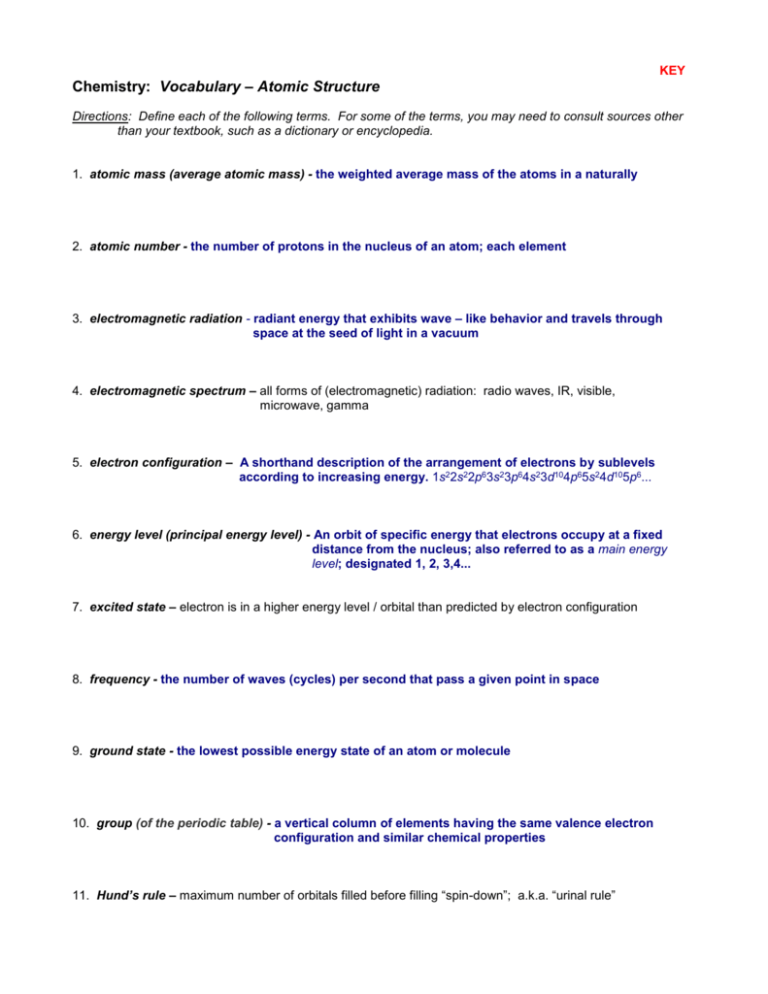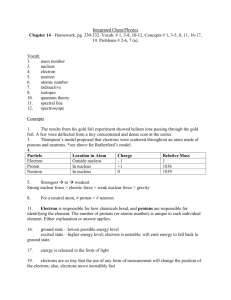Vocabulary "Atomic Structure"
advertisement

KEY Chemistry: Vocabulary – Atomic Structure Directions: Define each of the following terms. For some of the terms, you may need to consult sources other than your textbook, such as a dictionary or encyclopedia. 1. atomic mass (average atomic mass) - the weighted average mass of the atoms in a naturally 2. atomic number - the number of protons in the nucleus of an atom; each element 3. electromagnetic radiation - radiant energy that exhibits wave – like behavior and travels through space at the seed of light in a vacuum 4. electromagnetic spectrum – all forms of (electromagnetic) radiation: radio waves, IR, visible, microwave, gamma 5. electron configuration – A shorthand description of the arrangement of electrons by sublevels according to increasing energy. 1s22s22p63s23p64s23d104p65s24d105p6... 6. energy level (principal energy level) - An orbit of specific energy that electrons occupy at a fixed distance from the nucleus; also referred to as a main energy level; designated 1, 2, 3,4... 7. excited state – electron is in a higher energy level / orbital than predicted by electron configuration 8. frequency - the number of waves (cycles) per second that pass a given point in space 9. ground state - the lowest possible energy state of an atom or molecule 10. group (of the periodic table) - a vertical column of elements having the same valence electron configuration and similar chemical properties 11. Hund’s rule – maximum number of orbitals filled before filling “spin-down”; a.k.a. “urinal rule” KEY 12. isotope - are atoms with the same number of protons but a different number of neutrons 13. kernel electrons - an inner electron in an atom; (also called core electrons) one that is not in the outermost (valence) principle quantum level 14. Law of Definite Composition - the principle that states a compound always contains the same elements in the same proportion by mass 15. mass number - the total number of protons and neutrons in the atomic nucleus of an atom 16. nucleus - the small, dense center of positive charge in an atom 17. orbital - a representation of the space occupied by an electron in an atom; the probability distribution for the electron. A region is space surrounding the nucleus of an atom in which there is a high probability (95%) of finding an electron with a given energy. 18. orbital diagram 19. period - A horizontal row in the periodic table; a series of elements with properties that vary from metallic to nonmetallic. 20. quantum theory - a model of the atom that describes an electron in terms of its probability of being found in a particular location around the nucleus. [quantum mechanical atom] 21. valence electrons - the electrons in the outermost occupied principal quantum level of an atom 22. wavelength - the distance between two consecutive peaks or troughs in a wave NOTE: Words written in blue can be found on GLOSSARY at www.unit5.org/chemistry Other resources must be used to find additional words (e.g., textbook, online science dictionary)








